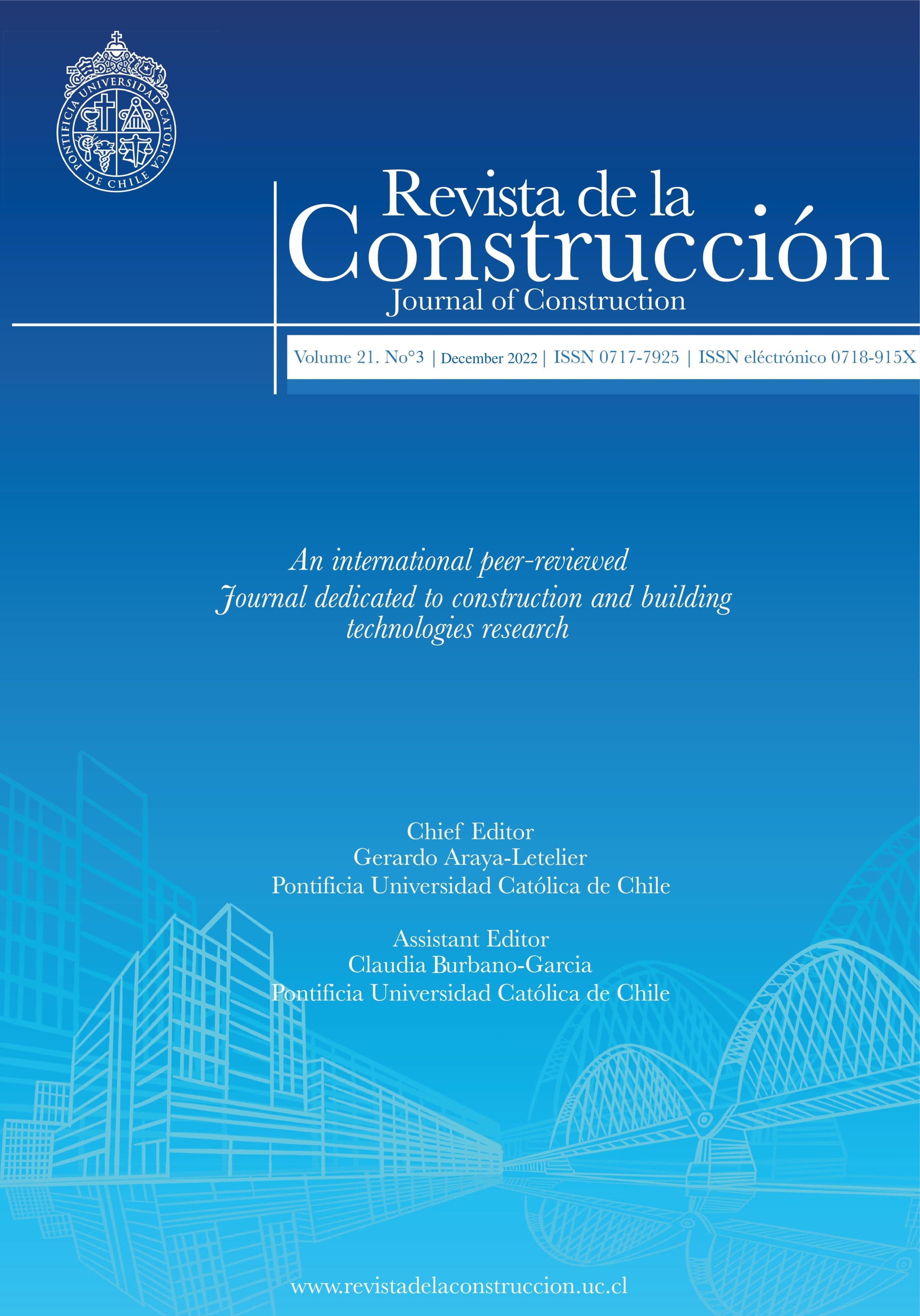Prediction of strength and shrinkage of ternary blended concrete with fly ash, slag and silica fume
DOI:
https://doi.org/10.7764/RDLC.21.3.669Keywords:
Supplementary cementitious materials (SCM), fly ash, silica fume, slag, long term performance, shrinkage, durability.Abstract
In the recent years, there has been increased in concern on shrinkage response of concrete systems as abundant cases of premature deterioration were reported. The major factors affecting the deterioration of a concrete system are quality, composition and the surrounding environment. In connection with this, the work concentrates on the study of long-term effects on materials used in the concrete (supplementary cementitious materials SCMs) such as fly ash, slag and silica fume as a blended concrete system. To carry out the experimental work, nine concrete mixes were designed for varying proportions of SCMs and w/b. Evolution of compressive strength, elastic modulus, shrinkage and selected durability parameters were tested under a controlled laboratory condition. Based on the work, it was found that the inclusion of fly ash, slag and silica fume on the concrete systems enhance the compressive strength in long-term, also the shrinkage response of the ternary systems shows a substantial reduction in the measured strain. Durability performance like chloride penetration and sorptivity had a better performance in comparison with the conventional concrete systems.
Downloads
References
Kar, A., Ray, I., Unnikrishnan, A., and Davalos, J. F, (2012). Composite modelling to predict shrinkage of concretes containing supplementary cementi-tious materials from paste volumes. Construction and Building Materials, 43, 139-155, DOI: 10.1016/j.conbuildmat.2013.01.002
Chore, H.S., & Joshi, M.P. (2015). Strength evaluation of concrete with fly ash and GGBFS as cement replacing materials. Advances in Concrete Con-struction, 3(3), 223–236. https://doi.org/10.12989/ACC.2015.3.3.223
Juengera, M.C.G. & Siddique, R. (2015). Recent advances in understanding the role of supplementary cementitious materials in concrete. Cement and Concrete Research, 78(1), 71-80, https://doi.org/10.1016/j.cemconres.2015.03.018.
Li, G., & Zhao, X. (2003), Properties of concrete incorporating fly ash and ground granulated blast-furnace slag. Cement and Concrete Composites, 25(3), 293-299. https://doi.org/10.1016/S0958-9465(02)00058-6.
Praveen Kumar, V. V., & Ravi Prasad, D. (2019). Influence of supplementary cementitious materials on strength and durability characteristics of concrete. Advances in Concrete Construction, 7(2), 75–85. https://doi.org/10.12989/ACC.2019.7.2.075
Sadrmomtazi, A., Tahmouresi, B., & Amooie, M. (2017). Permeability and mechanical properties of binary and ternary cementitious mixtures. Advances in Concrete Construction, 5(5), pp. 423–436. https://doi.org/10.12989/ACC.2017.5.5.423.
Akyuncu, V., Uysal, M., Tanyildizi, H., & Sumer, M. (2019). Modeling the weight and length changes of the concrete exposed to sulfate using artificial neural network. Revista De La Construcción. Journal of Construction, 17(3), 337-353. https://doi.org/10.7764/RDLC.17.3.337
Sakthivel, T., Gettu, R. & Pillai, R.G., (2019). Compressive Strength and Elastic Modulus of Concretes with Fly Ash and Slag. J. Inst. Eng. India Ser. A 100, 575–584. https://doi.org/10.1007/s40030-019-00376-w.
Mehta, P. K., & Monteiro, P. J. M. (2006), Concrete Structure, Properties, and Materials, 2nd Edition. Prentice Hall, Englewood Cliffs, NJ.
Neville, A.M., (2006), Properties of Concrete, 4th Edition, Pearson Education Asia Pvt. Ltd.
Gesoǧlu, M., Güneyisi, E., & Özbay, E. (2009). Properties of self-compacting concretes made with binary, ternary, and quaternary cementitious blends of fly ash, blast furnace slag, and silica fume. Construction and Building Materials, 23(5), 1847-1854.
Güneyisi, E., Gesoǧlu, M., Özbay, E. (2010). Strength and drying shrinkage properties of self- compacting concretes incorporating multi-system blended mineral admixtures. Construction and Building Materials, 24(10), 1878-1887. https://doi.org/10.1016/j.conbuildmat.2010.04.015.
Sumrerng, R., & Prinya, C. (2014). Use of Ternary Blend of Portland Cement and Two Pozzolans to Improve Durability of High-Strength Concrete. KSCE Journal of Civil Engineering,18(6),1745-1752. DoI: 10.1007/s12205-014-0461-y.
Alonso, M. C., García Calvo, J. L., Sánchez, M., and & Fernandez, A. (2012). Ternary mixes with high mineral additions contents and corrosion related properties. Materials and Corrosion, 63(12), 1078–1086, https://doi.org/10.1002/maco.201206654.
Richardson, M. G. (2002) Fundamentals of durable reinforced concrete, Spon Press, London.
IS 1727 (2004) Indian Standard methods of test for pozzolanic materials, Bureau of Indian Standards, New Delhi, India.
ASTM C204 (2011) Standard test methods for fineness of hydraulic cement by air permeability apparatus, American Society for Testing and Materials, USA.
IS 10262 (2010) Indian Standard concrete mix proportioning – guidelines, Bureau of Indian Standards, New Delhi.
IS 516 (2004) Indian standard methods of tests for strength of concrete, Bureau of Indian Standards, New Delhi, India
ASTM C469 (2010). Standard Test Method for Static Modulus of Elasticity and Poisson’s Ratio of Concrete in Compression, American Society of Testing and Materials, USA.
ASTM C157 (2008). Standard Test Method for Length Change of Hardened Hydraulic-Cement Mortar and Concrete, American Society of Testing and Materials, ASTM International, USA.
ASTM C1202 (2012), Standard Test Method for Electrical Indication of Concrete's Ability to Resist Chloride Ion Penetration, American Society for Test-ing and Materials, ASTM International, USA.
ASTM C1585 – 20, Standard Test Method for Measurement of Rate of Absorption of Water by Hydraulic-Cement Concretes, American Society for Test-ing and Materials, ASTM International, USA.
ACI 209.2R: 2008, American Concrete Institute Building Code Requirements for Modelling and Calculating Shrinkage and Creep in Hardened Concrete, American Concrete Institute, USA
Bažant, Z. P., Hubler, M. H., and Wendner, R., (2015) Model B4 for Concrete Creep and Shrinkage including Multi-Decade Applicability, Materials and Structures, pp. 753-770
fib Mode Code for Concrete Structures 2010, (2013). Earnest and Soln, Germany.
Sakthivel, T., Gettu, R. and Pillai, R. G. (2021). “Drying Shrinkage of Concrete with Blended Cementitious Binders Experimental Study and Application of Models”, The Indian Concrete Journal, Vol. 95, No. 10, pp. 34-50.
Downloads
Published
How to Cite
Issue
Section
License
Copyright (c) 2022 T Sakthivel, K Arulraj

This work is licensed under a Creative Commons Attribution-NonCommercial-NoDerivatives 4.0 International License.





